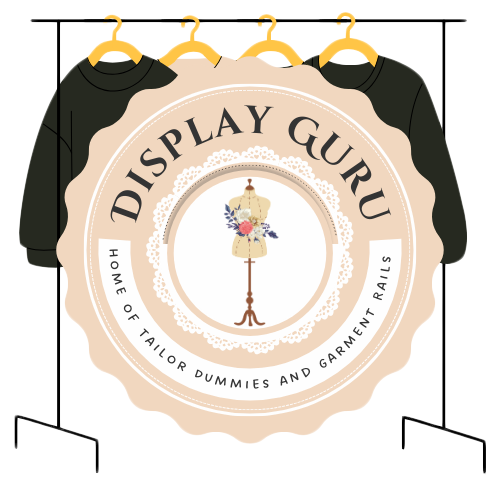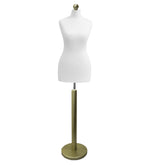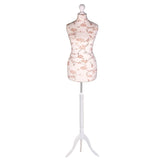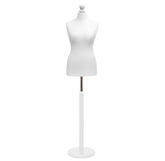Choosing Your Perfect Dress Form Stand
A dress form stand is the unsung hero of any sewing studio or retail space. It's the essential foundation that gives a dress form its stability, mobility, and adjustable height, making it a crucial piece of kit for anyone serious about garment creation or display.
What Makes a Dress Form Stand So Important?
Think of a dress form stand as the spine for your creative projects. A sculptor needs a strong armature to build their masterpiece, and in the same way, a designer or retailer needs a dependable stand to bring a garment to life. Without that solid base, even the highest-quality dress form is just a torso, unable to fulfil its potential. The stand is what makes it a truly functional tool.
The real magic happens when its core components—the base, the pole, and the height adjustment—work together seamlessly. It’s this synergy that determines whether your workflow is smooth and efficient or a constant source of frustration. A wobbly stand can completely ruin a delicate draping session, while one that’s a pain to adjust can slow down fittings and disrupt your creative flow.
The Foundation for Creative Work
A professional dress form stand does so much more than just hold a mannequin upright; it’s an active partner in the design and display process. Its main jobs are providing stability and adjustability, both of which are absolutely vital for several key tasks.
- Ensuring Stability: A well-built stand is your best defence against tipping, especially when you're working with heavy fabrics like wool or the extensive yardage needed for a wedding dress. This stability is non-negotiable for doing accurate work and keeping everyone safe in a busy studio or shop.
- Providing Mobility: Many stands come with castors (wheels), letting you glide the dress form around your workspace with ease. This is a game-changer when you need to move between a sewing machine, a cutting table, and a full-length mirror for fittings.
- Allowing Height Adjustment: Being able to raise or lower the form is a must-have feature. It lets you work on hemlines at a comfortable height without stooping, or adjust a display to the perfect eye-level for your customers.
The stand is what transforms a static mannequin into a dynamic tool. It's the difference between a simple display piece and a functional partner in creating beautifully fitted garments.
Ultimately, choosing the right stand is just as important as selecting the dress form itself. It supports your work, protects your garments, and provides the precision you need to achieve a truly professional finish. Understanding the role of a mannequin with stand is the first step towards creating more effective displays and better-fitting clothes.
A quality stand serves distinct but equally important purposes in both the design studio and the retail floor. Below is a quick look at how its core functions translate across these environments.
Core Functions of a Dress Form Stand
| Function | Importance in Sewing & Design | Importance in Retail & Display |
|---|---|---|
| Stability | Prevents tipping during draping, pinning, or fitting heavy garments. Ensures accuracy. | Keeps displays secure and safe in high-traffic areas. Protects valuable merchandise. |
| Mobility | Allows easy movement between workstations (sewing machine, cutting table, mirror). | Enables quick and easy changes to floor layouts and window displays without heavy lifting. |
| Adjustability | Crucial for working on different garment lengths (e.g., hemlines) at an ergonomic height. | Allows mannequins to be set at optimal eye-levels to attract customer attention. |
As you can see, these three functions are the bedrock of a stand's utility, making it an indispensable tool no matter how you use your dress form.
Core Components Working in Harmony
A stand’s performance really comes down to three key parts working together as a single, cohesive unit:
- The Base: This is the anchor. Its design—whether a classic tripod or a modern flat plate—and its weight are what dictate the stand's overall stability and how you can move it.
- The Central Pole: This provides the vertical structure and height. It needs to be made from a material robust enough to support the dress form's weight without any bending or flexing under pressure.
- The Adjustment Mechanism: This is how you control the height. It could be a simple screw-lock system or a more advanced hands-free foot pedal, but its job is to let you position the form at the precise height your task requires.
Finding the Right Foundation for Your Work
Think of your dress form's stand as the unsung hero of your sewing room or retail space. It’s the foundation, and just like building a house, if the foundation isn't right, everything built on top of it will be wobbly and frustrating. Choosing the right base isn't just a minor detail; it's a practical decision that dictates stability, mobility, and how easily you can bring your creative vision to life.
A good stand prevents tipping, lets you move around your workspace without a fuss, and ultimately makes your entire process smoother. This is especially true when you're getting to grips with complex pattern adjustments. If you're new to this, our guide on using an adjustable mannequin for sewing offers some fantastic insights into getting that perfect fit from the very beginning.
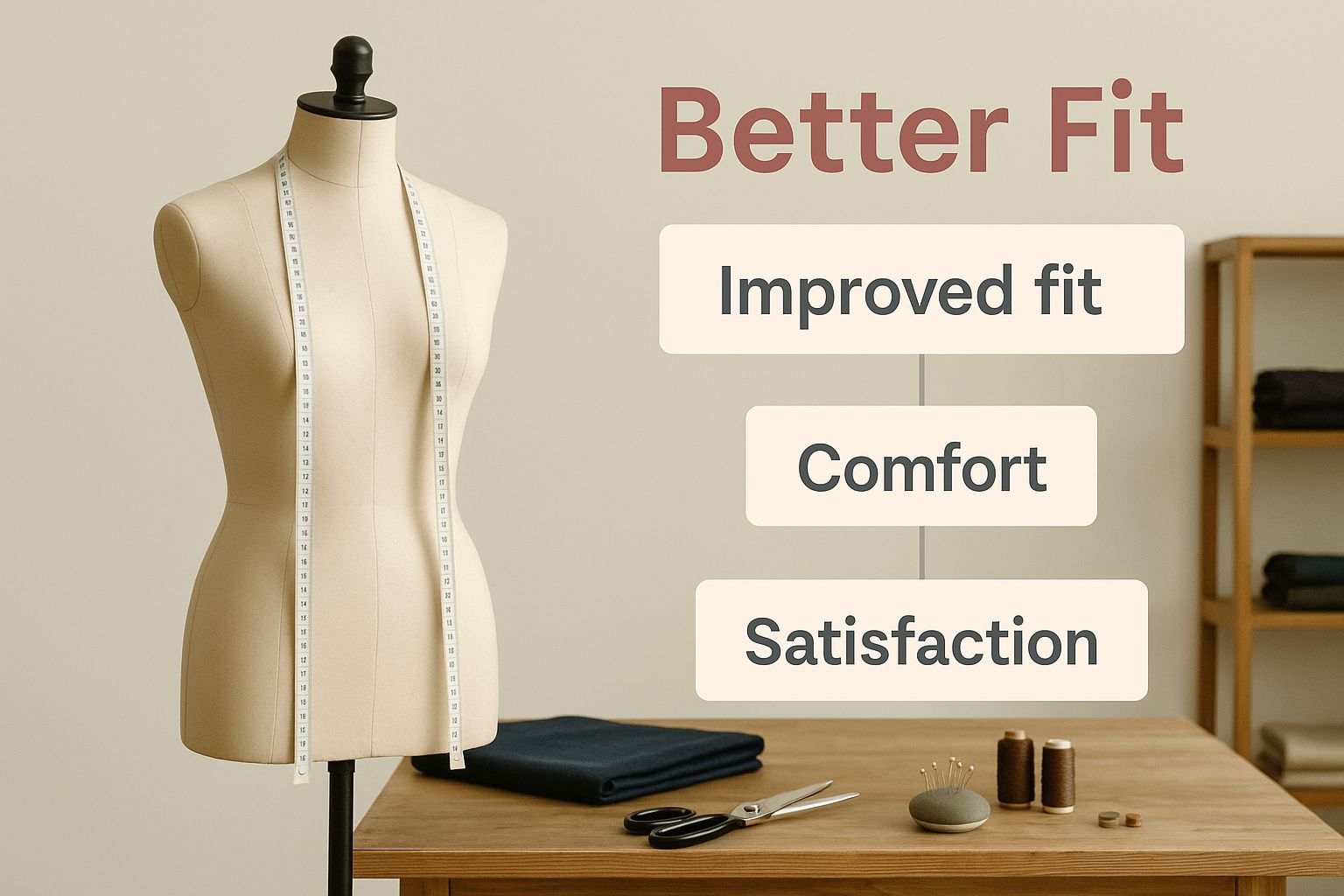
The image above really drives home the point: professional results start with professional-grade equipment, and a stable stand is ground zero.
The Classic Tripod Base
The tripod is what most people picture when they think of a dress form stand. With its three legs branching out from a central pole, its main advantage is agility. It’s brilliant for sewers who need to get right up close to their work.
Imagine you're switching between your sewing machine and your mannequin. A tripod base lets you pull the form right up beside your chair, making it easy to pin a seam and then swivel back to stitch it. Its design is also great for navigating the typical home studio, easily gliding over rug edges or stray power cords. The trade-off? Its smaller footprint can make it less stable with particularly heavy or off-balance garments. It's perfect for most dressmaking, but a voluminous velvet coat might test its limits.
The Sturdy Quad-Leg Base
Adding just one more leg makes a world of difference. A quad-leg base, with its four points of contact, offers a significant jump in stability. It creates a wider, more secure footprint that you can feel straight away.
This style is a fantastic all-rounder. You get much of the easy movement of a tripod but with the added peace of mind that comes from a sturdier foundation. It's a go-to choice for fashion students and designers who work with everything from lightweight silks to heavier wools and layered skirts.
- Increased Stability: The four-leg design dramatically cuts down the risk of tipping, even when a garment's weight isn't perfectly centred.
- Good Mobility: While a touch bulkier than a tripod, models with quality castors still move smoothly across the floor.
- Versatile Use: It’s a true workhorse, equally at home in a busy sewing studio or a retail shop where it might get bumped by customers.
This blend of security and movement makes the quad-leg base a dependable choice for almost any project or environment.
The Unshakeable Flat Metal Base
When your top priority is absolute, rock-solid stability, nothing comes close to a heavy, flat metal base. These are usually solid plates of cast iron or steel, creating an incredibly low centre of gravity that’s almost impossible to knock over.
Think of the flat base as the anchor for your studio. It’s the undisputed champion for handling the most demanding projects imaginable—from heavy bridal gowns with long, sweeping trains to full-length leather coats.
This is the base you choose when failure is not an option. Bridal boutiques rely on them to display priceless gowns in high-traffic areas, and costume designers trust them to support weighty, elaborate creations without a single wobble. The compromise, of course, is nimbleness. While most come with wheels, their sheer weight means they aren't designed to be zipped around the room like their lighter-legged cousins.
How Stand Materials Impact Performance and Style
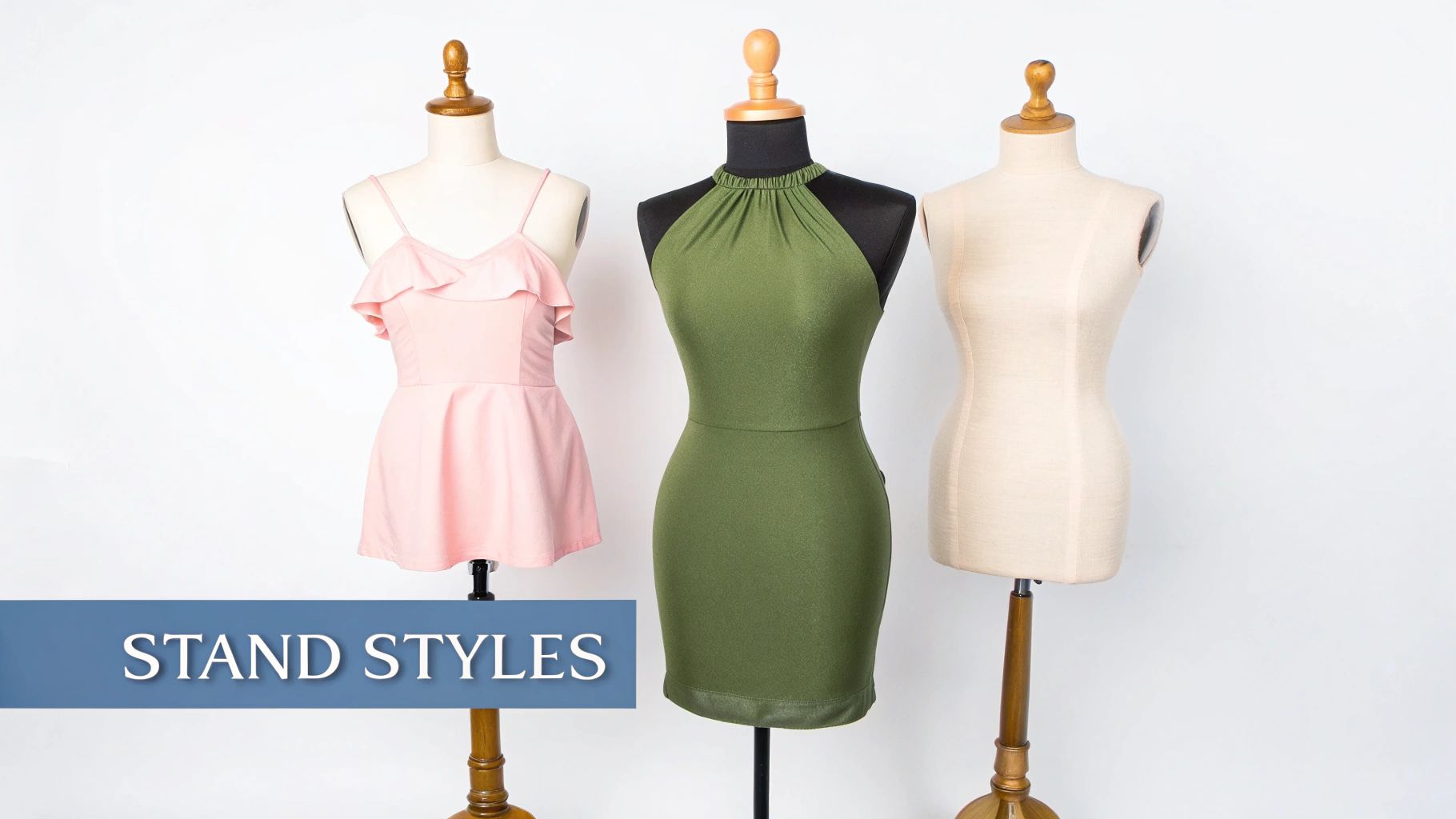
The material of your dress form stand does far more than just hold up the mannequin. It’s what gives the entire piece its character, its resilience, and ultimately, its usefulness in your day-to-day work. Deciding between classic wood, sturdy metal, or modern plastic is a real balancing act between your personal taste and your practical needs. The material you choose will directly affect the stand's weight, how stable it feels, and the overall vibe it brings to your workspace.
Think of it this way: a heavy metal stand is an absolute necessity for a studio that’s constantly wrestling with tough fabrics like denim, leather, or heavy wool. On the other hand, a lighter wooden or plastic stand could be the perfect partner for displaying delicate dresses in a shop or for occasional use in a home sewing room. The trick is to match the material to your specific projects and environment.
The Warmth and Tradition of Wood
There's something undeniably timeless about a wooden dress form stand. It brings a classic, warm feeling to any room, whether it’s a traditional atelier or a chic, minimalist boutique. Usually crafted from woods like beech, oak, or pine, their natural beauty alone makes them a hugely popular choice for display.
But it’s not just about looks; their practical features are just as important. Wood is relatively light, which makes these stands a breeze to move around and reposition. For home sewers or smaller shops that need that kind of flexibility, this is a massive plus.
- Aesthetic Appeal: Wood has a natural, elegant look that really makes garments shine.
- Lightweight Nature: They're generally much easier to shift and handle compared to their metal cousins.
- Potential Drawbacks: Be aware that wood can be more prone to dents and scratches, and it isn't a fan of moisture. It also might not have the raw strength needed for very heavy or awkwardly balanced projects.
Industrial Strength of Metal Stands
When your work demands absolute stability and no-nonsense durability, metal is the undisputed champion. These stands are typically forged from cast iron or chrome-plated steel—materials renowned for their incredible strength and weight.
A cast iron stand is the heavyweight of the bunch, giving you the rock-solid foundation needed for fitting heavy bridal gowns or draping full-length coats. The sheer bulk of a cast iron base keeps your form securely anchored, stopping any tipping or wobbling when you’re in the middle of intensive work. Chrome-plated steel offers a sleeker, more modern aesthetic while still delivering fantastic durability and resistance to rust and corrosion.
For professional dressmakers and busy retail environments, a heavy metal stand isn't a luxury—it's a fundamental piece of kit for safety, precision, and longevity. It's the true workhorse of the industry.
This choice is part of a bigger picture. The global mannequin market, which of course includes the vital dress form stand sector, is expected to reach $5.53 billion by 2025. While fibreglass has been a long-time favourite, there’s a growing appetite for more diverse and sustainable materials. Manufacturers are now offering more metal, wood, and recycled plastic options to cater to a more environmentally aware UK market. You can dive deeper into these trends over at Fortune Business Insights.
Modern Versatility with Plastics
While you don't see them as often, stands that use high-density plastics or polyurethane parts are carving out a niche as a practical and budget-friendly option. These modern materials offer a solution that’s lightweight, durable, and often much kinder to your wallet.
They are especially useful for pop-up shops, student projects, or any situation where being able to pack up and move quickly is the main goal. Plastic bases are also resistant to moisture and dead easy to clean, making them a low-maintenance choice for hectic settings. They might not have the heirloom quality of wood or the brute force of cast iron, but their versatility and affordability make them a smart pick for many people navigating the dynamic world of fashion and retail.
Essential Features That Elevate Your Workflow
Once you've settled on the base and material, it’s the smaller details of a dress form stand that really make the difference. These are the features that transform a simple piece of equipment into a genuine partner in your work. It's easy to get lost in marketing speak, but focusing on these practical elements is how you make a smart, lasting investment.
Think of it this way: a great stand should feel like an extension of your own hands. It should anticipate your next move and get out of your way, letting you focus entirely on the garment. You want a tool that works with you, not one you have to constantly fight against.
Height Adjustment Made Simple
Being able to easily change the height of your dress form is an absolute must-have. Anyone who has spent hours hunched over a form set at the wrong height knows this all too well. It's not just about comfort; it's about precision and protecting your back. There are two main mechanisms you'll come across.
First, you have the common manual screw-lock system. This is a straightforward setup where you loosen a knob, slide the pole up or down, and tighten it again. It's dependable and gets the job done, but it does require both hands, which can be a real juggle when you're also trying to hold fabric in place.
The real step up is the hands-free foot pedal. This brilliant mechanism lets you adjust the height with a simple press of your foot, leaving your hands completely free to manage the garment. Imagine you're draping a tricky bias cut or pinning a delicate hem—being able to make tiny height adjustments without letting go of the fabric is a massive boost for both your speed and accuracy.
For anyone who frequently changes their form's height during fittings or draping, a foot pedal isn't a luxury; it's a huge productivity gain. The time and frustration it saves really adds up over the years.
The Power of Mobility and Control
Mobility is another game-changer, but only when you can control it. This is where the quality of the wheels, or castors, really shines. Gliding your dress form across the studio floor is fantastic, but having it drift away while you’re trying to pin a perfectly straight seam is beyond frustrating.
That’s why lockable castors are non-negotiable for any stand on wheels. With a simple lever on the wheels, you can instantly switch the stand from mobile to completely stationary. It gives you the best of both worlds: effortless movement when you need it and rock-solid stability when you don't. Good quality castors will also roll smoothly across different surfaces, from hard concrete floors to thick carpet, without getting stuck.
Unlocking 360-Degree Rotation
Finally, look for the ability to spin the dress form on its stand. A 360-degree rotation feature lets you turn the form smoothly without having to shuffle the entire base around. This is incredibly useful for working on every side of a garment without constantly walking around it or contorting yourself into awkward positions.
When you’re draping, fitting, or just checking the symmetry of your design, being able to simply turn the form to face you saves a huge amount of time and physical effort. Many stands offer rotation, but the best ones include a lock to stop it from spinning when you need it to stay still. It's a simple feature, but it gives you total control over every angle of your project. For more ideas on arranging your workspace, have a look at our guide to creating effective clothing display stands that can enhance your setup.
Matching the Right Stand to Your Creative Needs
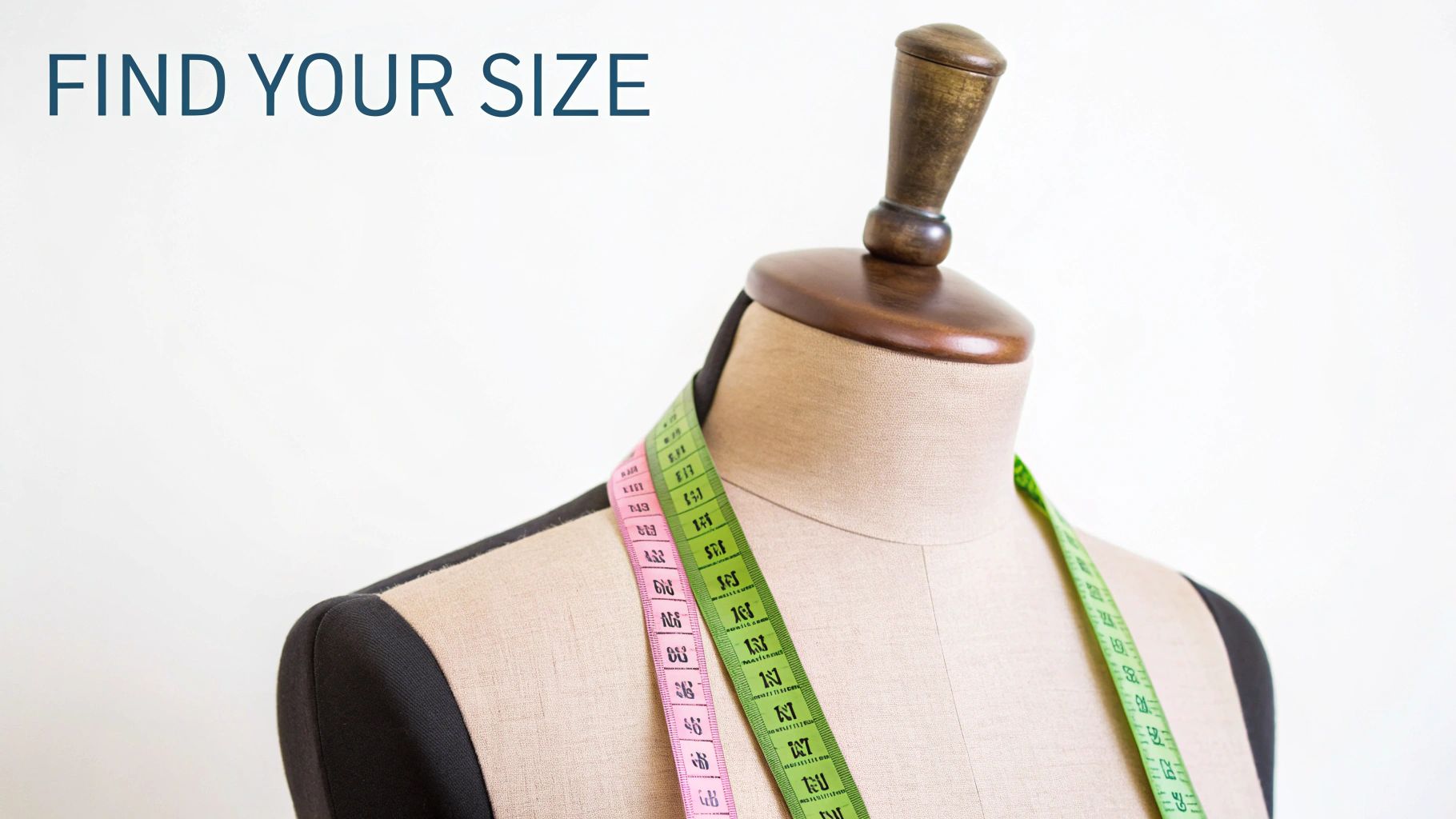 With so many different stands on the market, picking the right one can feel a bit daunting. The simplest way to cut through the options is to picture how you'll actually use it. By thinking about your day-to-day work, you can quickly spot the stand that will support your goals, not hinder them.
With so many different stands on the market, picking the right one can feel a bit daunting. The simplest way to cut through the options is to picture how you'll actually use it. By thinking about your day-to-day work, you can quickly spot the stand that will support your goals, not hinder them.
Let's explore a few real-world scenarios. See if you recognise your own needs in one of these examples. Thinking this way helps connect the dots between features, materials, and your own creative process, so you can make a decision you feel good about.
For the Home Sewing Enthusiast
Let’s start with the passionate home sewer. Your creative space might be a dedicated studio or just a cosy corner of the living room. You're likely tackling all sorts of projects, from simple dresses to maybe a more complex tailored jacket, and you need gear that’s practical and easy to manage at home.
You’re constantly moving between your sewing machine, ironing board, and a mirror to check the fit. A big, heavy industrial stand would just get in the way.
- Recommended Base: A wooden tripod base is the perfect partner here. Its three legs give it a small footprint, so you can easily tuck it into a corner or pull it close for quick pinning. It’s also light enough to move around without a struggle.
- Recommended Material: Wood just looks right in a home setting. It has a classic, warm feel that blends into your decor much better than a cold, industrial metal stand would. Plus, it's plenty durable for most dressmaking projects.
- Key Features: A simple screw-lock for changing the height is all you really need. If you can find one with lockable castors, that's a brilliant bonus – it stops your form from rolling away while you're working on it.
For a home sewer, the best stand is a blend of easy manoeuvrability and a touch of elegance. A wooden tripod delivers on both, giving you a stable platform for your creativity without taking over the room.
This kind of setup gives you the freedom to work on almost any garment while keeping your space tidy and functional. It’s a reliable partner for turning your fabric dreams into reality.
For the Professional Dressmaker or Tailor
Now, let's step into a professional dressmaker's bustling studio. Here, the dress form is a workhorse, in constant use from morning till night. You’re handling everything from whisper-thin silks to heavy wools for bespoke suits or weighty, elaborate gowns. Durability, precision, and efficiency aren't just nice-to-haves; they're vital to your business.
Your work demands a stand that can take constant adjustments and hold serious weight without a hint of a wobble. Time is money, so any feature that saves you a few seconds here and there really adds up.
- Recommended Base: A heavy-duty cast iron flat base is non-negotiable. Its sheer weight and low centre of gravity provide the rock-solid stability you need for heavy or off-balance garments, ensuring both safety and accuracy.
- Recommended Material: For this level of professional use, it has to be cast iron. It’s built to last a lifetime and can easily handle the daily demands of a busy studio.
- Key Features: A foot-pedal height adjustment is an absolute game-changer. It frees up your hands, letting you make adjustments on the fly, which dramatically speeds up your fitting and draping process. Good-quality, lockable castors are also essential for wheeling heavy forms across the studio floor.
This robust setup is the trusted workhorse of the fashion industry, engineered for pure performance and longevity.
For the Boutique Owner or Visual Merchandiser
Finally, imagine you're a boutique owner or a visual merchandiser. Your main job is to create displays that stop people in their tracks and show off your garments beautifully. Stability matters, of course, but the look of the stand is just as important—it's part of your shop's overall aesthetic.
The stand itself contributes to your brand image, whether you're going for a rustic, vintage vibe or something clean and modern. Effective displays are the lifeblood of the UK womenswear market, which was valued at a huge £24.8 billion in 2023. Growth in this sector depends on powerful visual merchandising, both on the high street and online.
- Recommended Base: A wooden tripod or a sleek chrome quad-leg base are both excellent choices. Your decision really comes down to your shop's style—wood for a classic, warm feel, or chrome for a sharp, contemporary look.
- Recommended Material: Wood or chrome-plated steel are the top contenders. They both offer a polished, high-end finish that complements fashion and elevates your entire display.
- Key Features: For display, a simple manual height adjustment is perfectly fine. The most critical feature is a clean, attractive design that lets the clothing shine. If you also use the forms for customer fittings, it's worth thinking about inclusive sizing; our guide on plus-size mannequins for stylish displays has some great advice on this.
Assembling and Maintaining Your New Stand
A high-quality dress form stand is a real workhorse and a long-term investment in your craft. If you treat it right from the get-go, it will be a stable, reliable partner for years to come. Proper assembly and a bit of routine maintenance are all it takes to keep it in peak condition.
When your new stand arrives, I know it’s tempting to tear open the box and put it together straight away. But take a moment. Lay out all the components and actually read the instructions first. Most are fairly intuitive—usually just attaching the base to the central pole and popping on the castors—but a quick look at the manual can save you from a classic mistake like installing a part upside-down. Ensure all screws are fully tightened to give yourself a secure, wobble-free foundation right from the start.
Keeping Your Stand in Top Shape
Just like any good tool, your stand needs a little upkeep to perform its best. A simple maintenance routine prevents the most common headaches and extends its life, whether you’re using it daily in a busy studio or just for the occasional project at home.
A quick clean now and then makes a world of difference. For metal or chrome stands, a soft, damp cloth is perfect for wiping away dust. If you have a wooden stand, stick to a dry microfibre cloth to avoid any risk of moisture damage.
Think of maintenance not as a chore, but as protecting your investment. A few minutes of care each month can prevent a wobbly base or a sticking pedal, ensuring your stand is always ready when inspiration strikes.
If your stand has castors, give them a quick check for stray threads or fluff that might have gotten tangled around the wheels. Clearing out this debris is all it takes to keep them gliding smoothly across your floor. And if the height-adjustment pedal starts to feel a bit stiff, a tiny dab of silicone lubricant will almost always get it working like new again.
Troubleshooting Common Problems
Even the sturdiest stands can have an off day. Don't worry, the fixes are usually very simple. Here’s how to tackle two of the most frequent issues:
-
A Wobbly Base: Nine times out of ten, this is just a loose connection. The first thing to do is check and tighten the main screw that connects the pole to the base. If it still wobbles, double-check that your floor is level.
-
A Sticking Height Adjustment: If you have a foot pedal, look for anything that might be physically blocking it. For manual screw-locks, make sure the threads are clean and clear of debris. In either case, a little lubricant can work wonders.
Following these simple steps will ensure your dress form stand remains a dependable and precise tool you can count on for every project.
Common Questions About Dress Form Stands
Even when you feel you’ve got a handle on the different bases, materials, and features, a few specific questions always seem to pop up just as you're about to decide. Getting straight answers to these common sticking points can be the final piece of the puzzle, giving you the confidence to pick the right dress form stand for your work.
So, let's dive into some of the questions I hear most often.
Compatibility and Stability Concerns
"Will any stand fit my dress form?" This is probably the number one query, and the honest answer is: not necessarily. It’s vital to check that the diameter of the stand's pole matches the opening in your dress form. While there are some standard sizes out there, many brands have their own unique fittings. Always measure both before buying a stand separately. You also need to be sure the stand is rated to handle the weight of your form.
Another big worry is stability, especially for anyone working with heavy fabrics. What’s the best choice for something like a wedding dress or a heavy wool coat? When you're dealing with garments like that, stability is everything. A heavy-duty cast iron stand with a wide, flat base is the undisputed champion here. It creates a low centre of gravity that makes it incredibly difficult to tip over.
For absolute peace of mind with valuable or heavy garments, always choose a stand with a solid, weighty base over a lighter, more mobile option. That extra stability is non-negotiable for both safety and precision.
Unwanted spinning while you’re trying to pin or drape is another classic frustration. The easiest way to solve this is to find a stand with a built-in locking mechanism. It’s usually a small screw or lever near the top of the pole that tightens onto the form's internal fitting, stopping it from rotating. Of course, a perfect fit starts with perfect measurements, and our guide on how to take body measurements for clothes is a great place to begin.
Workflow and Practicality Questions
Finally, people often ask about mobility: are stands with wheels (castors) really that much better? It honestly comes down to how you work. If you have a busy studio and need to move your form from a sewing machine to a cutting table, then yes, castors are a godsend. For a fixed retail display, however, a stationary stand often looks cleaner and can feel a touch more stable for its weight. If you do go for wheels, just make sure they have locks!
These tools are mainstays of the UK apparel market, a massive sector projected to pull in around £85.85 billion in revenue by the end of 2024. As the third-largest apparel market in the world, its growth is built on professional tools for both design and display. You can find more on these UK fashion industry statistics over at Spring Fair.
Ready to find the perfect foundation for your creative work? At Display Guru, we offer a comprehensive range of high-quality dress form stands to suit every need, from the home enthusiast to the professional retailer. https://www.displayguru.co.uk
